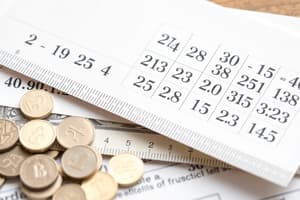Podcast
Questions and Answers
What does the first digit to the right of the decimal point represent?
What does the first digit to the right of the decimal point represent?
- Hundredths
- Tenths (correct)
- Ones
- Thousandths
1.75 is a whole number.
1.75 is a whole number.
False (B)
What is the formula for the area of a rectangle?
What is the formula for the area of a rectangle?
Area = length × width
1 meter is equal to ______ centimeters.
1 meter is equal to ______ centimeters.
Match the following units with what they typically measure:
Match the following units with what they typically measure:
Which of the following is NOT a unit of measurement for volume?
Which of the following is NOT a unit of measurement for volume?
Volume measures the surface of a two-dimensional shape.
Volume measures the surface of a two-dimensional shape.
Money is a medium of ______ that facilitates transactions.
Money is a medium of ______ that facilitates transactions.
The formula for calculating the volume of a cylinder is:
The formula for calculating the volume of a cylinder is:
Flashcards
Decimals
Decimals
Numbers with fractional parts, written using a decimal point.
Place value in decimals
Place value in decimals
The value of a digit in a decimal number based on its position.
Rounding decimals
Rounding decimals
Approximating a decimal to a specific place value.
Measurement
Measurement
Signup and view all the flashcards
Units of measurement
Units of measurement
Signup and view all the flashcards
Area
Area
Signup and view all the flashcards
Volume
Volume
Signup and view all the flashcards
Area of rectangle
Area of rectangle
Signup and view all the flashcards
Volume of cube
Volume of cube
Signup and view all the flashcards
Money
Money
Signup and view all the flashcards
Study Notes
Decimals
- Decimals represent numbers with fractional parts, written using a decimal point.
- They are a way to express numbers that are not whole numbers.
- A decimal number has a whole number part and a fractional part separated by a decimal point.
- Examples: 2.5, 0.75, 10.03
- Place value in decimals is based on powers of ten. The first digit to the right of the decimal point represents tenths, the second represents hundredths, the third represents thousandths, and so on.
- Comparing decimals requires considering place values from left to right and determining which digits are greater or smaller in each place value.
- Rounding decimals involves approximating the value to a specified place value. Rules for rounding involve looking at the digit to the right of the place value to be rounded.
Measurement
- Measurement involves assigning numerical values to physical attributes such as length, weight, volume, and time.
- Units of measurement are standardized values used to express quantities.
- Common units of measurement include:
- Length: meters (m), centimeters (cm), millimeters (mm), kilometers (km)
- Weight/Mass: grams (g), kilograms (kg), milligrams (mg), tonnes (t)
- Volume: liters (l), milliliters (ml)
- Time: seconds (s), minutes (min), hours (hr), days, weeks, months, years
- Converting between units of measurement involves multiplying or dividing by appropriate conversion factors. For example, 1 meter = 100 centimeters.
- Understanding the relationships between different units is crucial in problem-solving and practical applications.
Area and Volume
- Area is the measure of the surface of a two-dimensional shape.
- Volume is the measure of the space occupied by a three-dimensional object.
- Area calculations depend on the shape:
- Rectangle: Area = length × width
- Triangle: Area = ½ × base × height
- Circle: Area = π × radius² (π is a mathematical constant approximately equal to 3.14)
- Volume calculations also vary depending on the shape:
- Cube: Volume = length³
- Rectangular Prism: Volume = length × width × height
- Cylinder: Volume = π × radius² × height
- Area calculations are crucial for determining surface measurements, while volume is necessary for calculating the space a solid object occupies.
Money
- Money is a medium of exchange that facilitates transactions between individuals and businesses.
- Common currency units include dollars, pounds, euros, and yen.
- Decimals are essential for working with money, as amounts are often expressed in cents (or other subdivisions of the currency).
- Calculations with money involve addition, subtraction, multiplication, and division.
- Fractions can also be used for representing or calculating money.
- Budgeting and tracking income and expenses often use monetary calculations.
- Understanding exchange rates (the value of one currency in relation to another) is critical in international transactions.
- Bank accounts and transactions require the use of money and decimal operations.
Studying That Suits You
Use AI to generate personalized quizzes and flashcards to suit your learning preferences.




